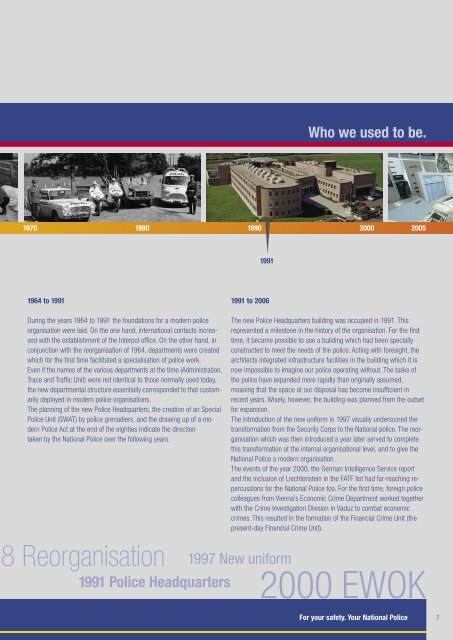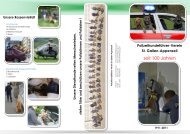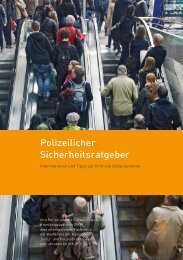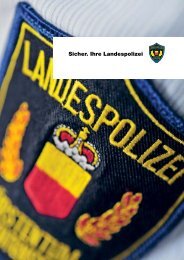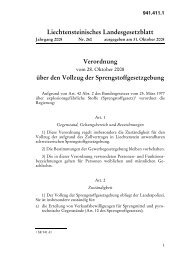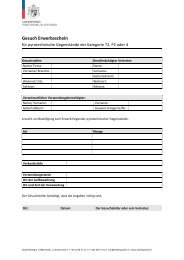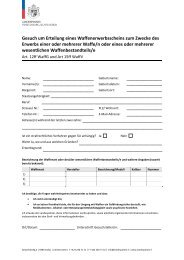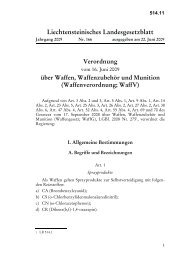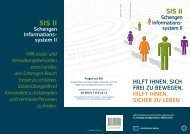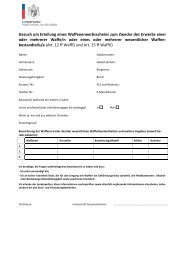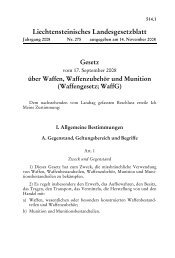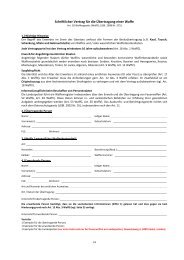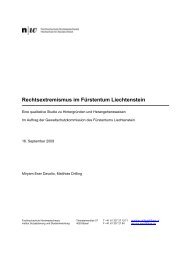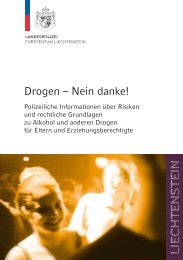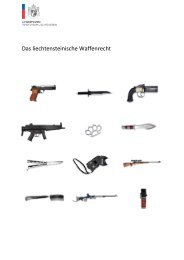This is who we are. - Landespolizei Liechtenstein
This is who we are. - Landespolizei Liechtenstein
This is who we are. - Landespolizei Liechtenstein
Create successful ePaper yourself
Turn your PDF publications into a flip-book with our unique Google optimized e-Paper software.
1970<br />
1964 to 1991<br />
1980<br />
During the years 1964 to 1991 the foundations for a modern police<br />
organ<strong>is</strong>ation <strong>we</strong>re laid. On the one hand, international contacts increased<br />
with the establ<strong>is</strong>hment of the Interpol office. On the other hand, in<br />
conjunction with the reorgan<strong>is</strong>ation of 1964, departments <strong>we</strong>re created<br />
which for the first time facilitated a special<strong>is</strong>ation of police work.<br />
Even if the names of the various departments at the time (Admin<strong>is</strong>tration,<br />
Trace and Traffic Unit) <strong>we</strong>re not identical to those normally used today,<br />
the new departmental structure essentially corresponded to that customarily<br />
deployed in modern police organ<strong>is</strong>ations.<br />
The planning of the new Police Headquarters, the creation of an Special<br />
Police Unit (SWAT) by police grenadiers, and the drawing up of a modern<br />
Police Act at the end of the eighties indicate the direction<br />
taken by the National Police over the following years.<br />
8 Reorgan<strong>is</strong>ation<br />
1991 Police Headquarters<br />
1990<br />
1991<br />
1991 to 2006<br />
Who <strong>we</strong> used to be.<br />
2000 2005<br />
The new Police Headquarters building was occupied in 1991. <strong>Th<strong>is</strong></strong><br />
represented a milestone in the h<strong>is</strong>tory of the organ<strong>is</strong>ation. For the first<br />
time, it became possible to use a building which had been specially<br />
constructed to meet the needs of the police. Acting with foresight, the<br />
architects integrated infrastructure facilities in the building which it <strong>is</strong><br />
now impossible to imagine our police operating without. The tasks of<br />
the police have expanded more rapidly than originally assumed,<br />
meaning that the space at our d<strong>is</strong>posal has become insufficient in<br />
recent years. W<strong>is</strong>ely, ho<strong>we</strong>ver, the building was planned from the outset<br />
for expansion.<br />
The introduction of the new uniform in 1997 v<strong>is</strong>ually underscored the<br />
transformation from the Security Corps to the National police. The reorgan<strong>is</strong>ation<br />
which was then introduced a year later served to complete<br />
th<strong>is</strong> transformation at the internal organ<strong>is</strong>ational level, and to give the<br />
National Police a modern organ<strong>is</strong>ation.<br />
The events of the year 2000, the German Intelligence Service report<br />
and the inclusion of <strong>Liechtenstein</strong> in the FATF l<strong>is</strong>t had far-reaching repercussions<br />
for the National Police too. For the first time, foreign police<br />
colleagues from Vienna’s Economic Crime Department worked together<br />
with the Crime Investigation Div<strong>is</strong>ion in Vaduz to combat economic<br />
crimes. <strong>Th<strong>is</strong></strong> resulted in the formation of the Financial Crime Unit (the<br />
present-day Financial Crime Unit).<br />
1997 New uniform<br />
2000 EWOK<br />
Sicher. Ihre <strong>Landespolizei</strong> 7<br />
For your safety. Your National Police 7


